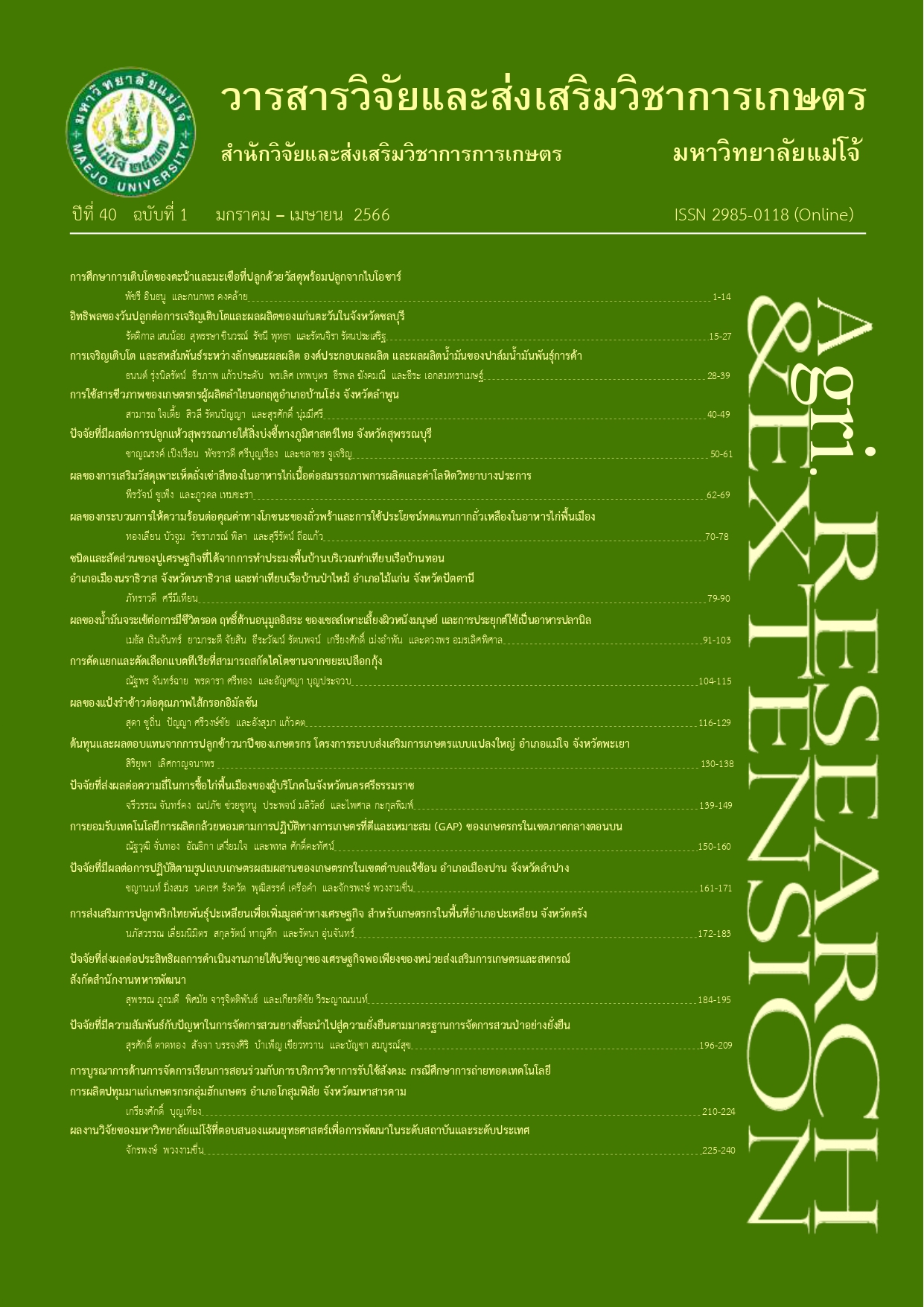ผลของแป้งรำข้าวต่อคุณภาพไส้กรอกอิมัลชัน
คำสำคัญ:
แป้งรำข้าว, ผลิตภัณฑ์เนื้อสัตว์ , ไส้กรอก อิมัลชันบทคัดย่อ
งานวิจัยมีวัตถุประสงค์เพื่อศึกษาผลของแป้ง รำข้าวต่อคุณภาพไส้กรอกอิมัลชัน โดยแปรผันปริมาณ แป้งรำข้าวออกเป็น 4 สูตร ได้แก่ 0% (สูตรควบคุม) สูตรใส่แป้งรำข้าว 1, 3 และ 5% ของอัตราส่วนเนื้อหมู จากผลการศึกษาคุณสมบัติทางเคมี พบว่าการใส่แป้งรำข้าว ในไส้กรอกที่เพิ่มขึ้นส่งผลให้ปริมาณความชื้น โปรตีน ใยอาหาร และเถ้า มีแนวโน้มเพิ่มขึ้น ในขณะที่ปริมาณไขมันลดลงเมื่อเปรียบเทียบกับสูตรควบคุม (P<0.05) และเมื่อระยะเวลาการเก็บรักษาเพิ่มขึ้น พบว่าค่าความหืน (TBARS) เพิ่มขึ้น แต่น้อยกว่าสูตรควบคุม (P<0.05) คุณสมบัติทางกายภาพ พบว่าการใส่แป้งรำข้าวในไส้กรอกที่เพิ่มขึ้นส่งผลให้การสูญเสียน้ำหนักและค่ากิจกรรมของน้ำเพิ่มขึ้น ในขณะที่ความสามารถในการอุ้มน้ำลดลง เมื่อเปรียบเทียบกับสูตรควบคุม (P<0.05) เมื่อวัดค่าสีผลิตภัณฑ์ พบว่าการใส่แป้งรำข้าวในไส้กรอกที่เพิ่มขึ้นส่งผลให้ค่าความสว่าง (L*) และค่าสีแดง (a*) ลดลง แต่ค่าสีเหลือง (b*) เพิ่มขึ้นเมื่อเปรียบเทียบกับสูตรควบคุม ลักษณะเนื้อสัมผัส พบว่าการใส่แป้งรำข้าวในไส้กรอก ที่เพิ่มขึ้นส่งผลให้ความแน่นเนื้อ ความแข็ง และความยากต่อการเคี้ยวลดลงเมื่อเปรียบเทียบกับสูตรควบคุม (P<0.05) สำหรับคุณสมบัติทางประสาทสัมผัส พบว่าการใส่แป้งรำข้าวในไส้กรอกที่ 1 และ 3 % ของอัตราส่วนเนื้อหมู มีคะแนนด้านลักษณะที่ปรากฏ สี กลิ่นรส เนื้อสัมผัส และการยอมรับโดยรวมไม่แตกต่างจากสูตรควบคุม (P>0.05) ในขณะที่การใส่แป้งรำข้าวในไส้กรอกที่ 5% ของอัตราส่วนเนื้อหมูส่งผลให้คะแนนด้านเนื้อสัมผัสและการยอมรับโดยรวมน้อยกว่าสูตรควบคุม (P<0.05) ดังนั้น มีความเป็นไปได้ในการนำแป้งรำข้าวมาใช้เป็นวัตถุดิบทางเลือกเพื่อทดแทนการใช้ไขมันหมูในผลิตภัณฑ์ไส้กรอกอิมัลชัน
เอกสารอ้างอิง
AOAC. 2000. Official Methods of Analysis. 17thed. Washington, DC: The Association of Official Analytical Chemists. 771 p.
Choe, J.H., H.Y. Kim, J.M. Lee, Y.J. Kim and C.J. Kim. 2013. Quality of frankfurter-type sausages with added pig skin and wheat fiber mixture as fat replacers. Meat Sci. 93: 849-854.
Choi, Y.S., J.Y. Jeong, J.H. Choi, D.J. Han,H.Y. Kim, M.A. Lee, H.W. Kim, H.D. Paik and C.L. Kim. 2008. Effects of dietary fiber from rice bran on the quality characteristics of emulsion-type sausages. Korean. J. Food sci. Ani. Resour. 28(1): 14-20.
Choi, Y.S., H.W. Kim, K.E. Hwang, D.H. Song, T.J. Jeong, Y.B. Kim, K.H. Jeon and C.J. Kim. 2015. Effects of fat levels and rice bran fiber on the chemical, textural and sensory properties of frankfurters. Food Sci. Biotechnol. 24(2): 489-495.
Hristo, D., H. Fejzulla and S. Todor. 2013. Study on factors (pH, water activity, salt content) affecting the growth of Listeria monocytogenes in raw dried cured sausages. Maced. Vet. Rev. 36(2): 91-95.
Kaewkred, K. and S. Choothin. 2018. Application of pre-gelatinized banana flour and rice bran oil in frankfurter sausages. Agric. Sci. J 49(2)(Suppl.): 613-616. [in Thai]
Kailomsom, S. 2015. Product development of reduced fat chicken holy basil sausage using konjac flour in combination with xanthan gum. JOA. 31(1): 77-87. [in Thai]
King Rice Oil Group. 2017. Rice bran flour. [Online]. Available https://kingriceoilgroup.com/th/food/rice-bran-flour/ (6 November 2021).
Livestock Product Research and Development Center. 2018. European Products: Ham, German Sausage, Bacon. Chiang Mai: Division of Livestock Products. 35 p. [in Thai]
Lorenzo, J.M., D.J.F. Ruiz and J. Carballo. 2016. Fat Content of Dry-cured Sausages and Its Effect on Chemical, Physical, Textural and Sensory properties. pp. 474-487. In Zdolec, N. (ed.). Fermented Meat Products: Health Aspects. Berlin: CRC Press.
Luo, Z. and Z. Xu. 2011. Characteristics and application of enzyme-modified carboxymethyl starch in sausages. LWT-Food Sci. Technol. 44: 1993-1998.
Pearson, D. 1976. The Chemical Analysis of Food. London: Churchill Living Stine. 498 p.
Phonpannawit, A., B. Khueanphet and K. Fungcharoensak. 2021. Product development of reduced fat chicken emulsion-type sausage using carrageenan and soy protein isolate. YRUJST. 6(2): 126-136. [in Thai]
Phonsaen, K., T. Rojanakorn and S. Uriyapongsan. 2016. Effect of pork back fat substitution with pre-emulsified rice bran oil on quality characteristics of Vienna sausage. Khon Kaen Agr. J. 44(2): 305-314. [in Thai]
Priprem, A., P. Chitropas and B. Sripanidkulchai. 2005. Rice bran: its value for health. Journal of Academic Service Centre Khon Kaen University 13(3): 4-9. [in Thai]
Reddy, K.P. and T.M.R. Shetty. 1996. An intermediate moisture product from mackerel (Rastrelliger kanagurta) using salt curing, fermentation and drying. J. Aquat. Food Prod. Technol. 5(20): 65-82.
Santiwattana, P. and T. Sirisukpornchai. 2016. Effect of replacing pork with defatted rice bran flour for deep fried minced pork and qualities of the used frying oil. TSTJ. 24(3): 432-442. [in Thai]
Sutcharittham, S., A. Aussanasuwannakul, J. Runglerdkriangkrai and J. Maneerote. 2017. Effect of Pre-emulsified Oil on Physico-chemical Properties in Fish Emulsion Sausage. pp. 542-549. In Proceedings of The 55th KU-BK Conference January 31 – February 3, 2017. Bangkok: Kasetsart University. [in Thai]
Suwonsichon, S. 2007. Effects of tapioca starch and acid-modified tapioca starch as fat replacers on qualities of low fat frankfurters. TSTJ. 15(1): 36-49. [in Thai]
Tadakottisarn, S. 2018. Albumin from Thai rice: super food for health. [Online]. Available https://www.arda.or.th/ebook/file/24rice.pdf (6 November 2021).
Tanikawa, E. 1985. Marine Products in Japan. 2nd ed. Tokyo: Kaseisha-Kasukaku Press. 506 p.
Viriyacharee, P. 1993. Sensory Planning and Analysis. Chiang Mai: Department of product development technology, Faculty of Agro-Industry, Chiang Mai University. 275 p. [in Thai]
Wattanapahu, S. and S. Dit-udom-po. 2007. Effects of tripolyphosphate substitution with hydrocolloids on physical and sensory properties of emulsion-type pork sausages. SWU Sci. J. 23(1): 48-56. [in Thai]
Wattanasiritham, L.S. 2018. Rice bran oil for health. Food 48(1): 50-55. [in Thai]
ดาวน์โหลด
เผยแพร่แล้ว
รูปแบบการอ้างอิง
ฉบับ
ประเภทบทความ
สัญญาอนุญาต
ลิขสิทธิ์ (c) 2023 วารสารวิจัยและส่งเสริมวิชาการเกษตร

อนุญาตภายใต้เงื่อนไข Creative Commons Attribution-NonCommercial-NoDerivatives 4.0 International License.
บทความนี้ได้รับการเผยแพร่ภายใต้สัญญาอนุญาต Creative Commons Attribution-NonCommercial-NoDerivatives 4.0 International (CC BY-NC-ND 4.0) ซึ่งอนุญาตให้ผู้อื่นสามารถแชร์บทความได้โดยให้เครดิตผู้เขียนและห้ามนำไปใช้เพื่อการค้าหรือดัดแปลง หากต้องการใช้งานซ้ำในลักษณะอื่น ๆ หรือการเผยแพร่ซ้ำ จำเป็นต้องได้รับอนุญาตจากวารสาร





